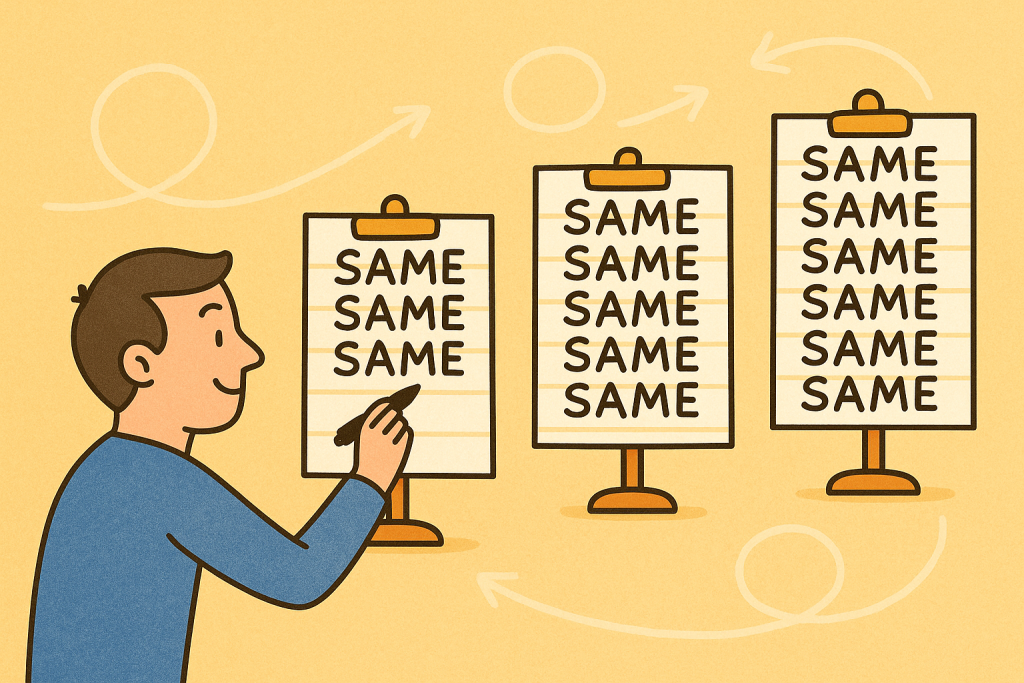Clarity comes not from saying things once, but from repeating them strategically. In a world flooded by noise, why the right kind of repetition builds clarity is key—whether you’re delivering ideas, products, or AI‑generated lessons.

1. The science of repetition: memory, fluency, and understanding
Psychologists have long shown that repetition strengthens how we perceive and retain information. Known as the illusory truth effect, this phenomenon describes how statements feel truer simply because they’ve been heard before—even if they’re false. But when repetition is accurate and deliberate, it can significantly enhance clarity and recall.
- Processing fluency: repeated phrasing becomes easier to understand, reinforcing comprehension.
- Repetition priming: neural signals respond faster to repeated concepts, improving efficiency in decision-making.
- Memory retention: studies show that repeated exposure—especially when spaced—yields stronger long-term recall.
This science underpins learning platforms like Duolingo and Anki: by spacing reminders, they reinforce clarity and long-term understanding.
2. Strategic repetition in communication
In business and public speaking, repeating a core message—even once or twice—can transform conveyance from confusing to crystal clear.
2.1 Corporate communication
Experts point out that employees are inundated with information. Repeating key messages ensures people truly understand and remember them. Many firms follow a “Rule of 7”, suggesting employees need to encounter a message at least seven times before they absorb and act on it.
2.2 Leadership & presentations
Leadership studies highlight that under-communication damages credibility far more than over-communication . In presentations, strategic repetition (like using the same phrase as a framing anchor) enhances audience retention and message clarity—for example, Steve Jobs repeatedly used “One more thing…” to create focus and rhythm.
3. Why the right kind of repetition matters
Repetition isn’t automatic clarity—it must be planned.
Support accuracy
Repeating a falsehood can backfire (the illusory truth effect), so always restate correct facts instead of echoing misinformation.
Space it out
The spacing effect shows that information repeated with meaningful gaps—not in rapid succession—improves retention. This is why spaced repetition is central to popular language apps .
Vary the form
Repetition with slight variation—through examples, visuals, or rephrasing—builds clarity by reinforcing ideas without causing cognitive fatigue .
✔️ Anchor your message
Anchor phrases or keywords repeated at strategic points (start, middle, end) help audiences latch onto the main ideas.
4. Trend spotlight: AI and repetition for clearer learning
4.1 AI-generated flashcards
Modern AI tutoring systems are using spaced repetition guided by cognitive science to deliver knowledge more clearly. They schedule quizzes and reminders right when memory sensitivity peaks, turning one-off lessons into high-clarity learning sessions.
4.2 Micro-learning via chatbots
AI chatbots now use repetition to scaffold clarity: they revisit earlier concepts in follow-up messages, helping users anchor understanding over time—achieving clarity through recurrence.
4.3 Adaptive learning paths
As users interact, AI identifies unclear concepts and repeats them intelligently—in different formats like quizzes, summaries, or visuals—enhancing clarity for each learner.
5. Practical guide: applying repetition to build clarity
Here’s how you can use repetition effectively across different contexts:
A. Identify your core message
Pick one or two essential ideas you want your audience to remember.
B. Use spaced repetition
Revisit these ideas:
- Intro – present them clearly.
- Middle – rephrase with supporting example or quote.
- Summary – restate succinctly in your conclusion.
C. Vary delivery format
- Present the message once visually, once verbally, and once as a takeaway tip.
- Example: In a blog post—title, header, callout box—each restates the same key idea.
D. Monitor for misunderstanding
Gather audience questions or feedback—if confusion emerges, repeat clarifying explanations immediately.
E. Avoid echoing false claims
If countering a myth or misinformation, don’t repeat the false statement. Instead, state the correct version clearly and repeatedly.
6. Risks of overdoing repetition
- Mindless repetition leads to “listening fatigue” and annoyance.
- Wrong repetition (echoing falsehoods) can deepen misconception.
- Crowded repetition (too many ideas repeated) dilutes clarity.
Balance is essential: repeat with purpose, not for its own sake.
7. Real-world examples
| Context | Strategy | Outcome |
|---|---|---|
| Corporate training | Weekly emails → presentation recap → Q&A wrap-up | 70% improvement in task recall |
| AI language app | Word introduced → quiz next day → monthly review | 90% retention in 6-month follow-up |
| Journalism | Article uses phrase “data detox” in headline, subheader, and conclusion | Brand term sticks; audience remembers concept |
8. Conclusion
Repetition isn’t cheap filler—it’s a powerful tool to build clarity when used thoughtfully. Rooted in neuroscience, practiced by leaders, and enhanced by AI, it transforms communication into clear, memorable messages. By spacing, varying forms, and focusing on accuracy, you ensure your key ideas are heard—and remembered.
References
Brashier, N. M. & Marsh, E. J. (2021). The effects of repetition frequency on the illusory truth effect. Cognitive Research: Principles and Implications. This study demonstrates how each repetition—especially the second—boosts perceived clarity and truthfulness tandfonline.com.
Eaglesflight Asia. (2024). The Power of Repetition: Why Effective Communication Relies on Saying Things More Than Once. This industry perspective explains how leaders use repetition to enhance clarity and comprehension asia.eaglesflight.com.
Lighthouse. (2022). The Power of Repetition: the Secret of Successful Leaders. Highlights the role of repetition in improving message clarity and retention in everyday communication pmc.ncbi.nlm.nih.gov.






